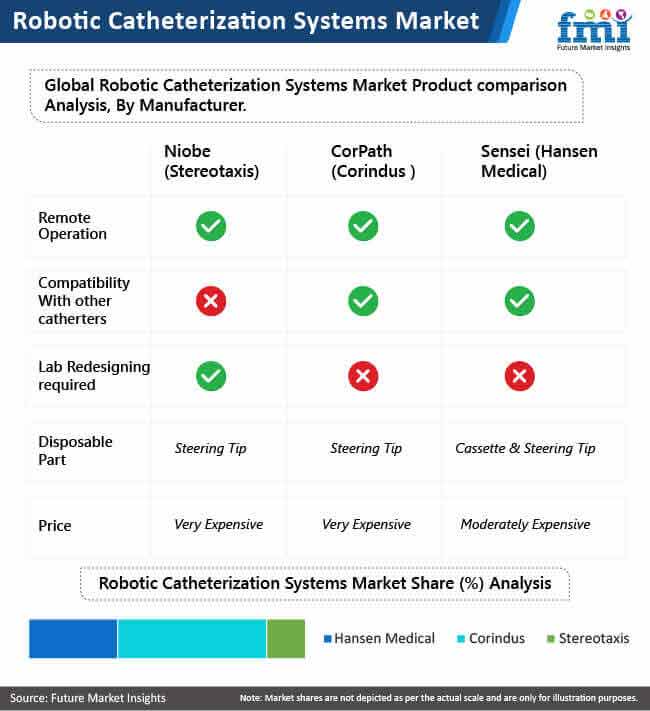A recent clinical study radiation level research with robotic catheterization and normal cardiac intervention procedures reveals that robotic catheterization systems show reduction of ionizing radiation exposure by 95%. This factor will be prominent in pushing the preference for robotic catheterization systems as an effective procedure for catheterization. Projected to reach US$ 26 Mn by the end of 2019, robotic catheterization systems market is set to thrive at an impressive CAGR of 15% during the forecast period (2019 – 2029).
Interventional and surgical robotic systems have already made a significant impact on how surgeries are performed and are being increasingly adopted in modern operating rooms. Robotic catheterization systems have proved their abilities to perform interventional procedures with immensely low operator radiation exposure in comparison to the tradition catheterization procedures. Procedures where clinicians are given navigational and mechanical tools that permit definite actions or part of the procedure to be executed autonomously with a level of precession and control are possible only with robot-assisted catheterization.
Key Takeaways – Robotic Catheterization Systems Market Study
- Popularity of robotic catheterization systems, increasing system awareness, improving reimbursement scenarios for percutaneous coronary intervention (PCI), larger patient pool for coronary artery diseases are key factors influencing the robotic catheterization systems market in developed countries.
- High upfront cost is posing a negative impact on end users’ decision to purchase robotic catheterized systems. To rework this problem, Hansen Medical is offering sensei system at a competitive pricing depicting lower accessory cost and lower total cost per procedure.
- Robotic catheterization systems installed in Chesapeake Regional Healthcare marks as the first fully integrated catheterization laboratory installed in its all intervention operating room.
- In terms of product type, electromechanical robotic catheterization systems with comparatively higher technical advantage over magnetic-guided robotic catheterization systems is expected to generate significant revenue.
- In terms of application, increasing adoption of robotic catheterization for percutaneous coronary intervention as compared to cardiac electrophysiology procedure marks higher revenue potential.
The first ever successful robotic PCI procedure in Asia Pacific that delivered positive results will be offering an inception point for the growth of robotic catheterization systems market in developing Asian economies.
Request Report Sample @ https://www.futuremarketinsights.com/reports/sample/rep-gb-9667
Market Leaders on Acquisition Spree
In reference to the trend in other medical device markets, key factors impacting the robotic catheterization systems market are partnerships and mergers observed in recent years. Key manufacturers are entering the robotic catheterization systems market by strategically expanding their reach through acquisitions and mergers, considering the increasing demand for these systems.
Product bundling of robotic catheterization and accessory systems at promotional rates and research contracts are forcing a decline in ASPs. Companies are focusing on limiting operational expenses to grow profitability. In contrast to these market changes, another significant factor influencing the robotic catheterization systems market is the exit and entrance of co-participating companies.
In August 2019, Corindus Vascular Robotics Inc., a prominent developer of precision vascular robotics, declared that it has settled on acquisition by Siemens Healthineers AG., representing a collective purchase price of approximately $1.1 billion. In April 2016, Hansen Medical Inc. was acquired by Auris Surgical Robotics Inc. in an arrangement with roughly US$ 80 Mn of equity value. With Hansen portfolio, Auris attained Magellan Robotic System, employed in navigating peripheral blood vessels in endovascular procedures, and Sensei Robotic System, a robotically steerable catheter system.

Looking for More Insights?
Robotic catheterization systems market, a new study from Future Market Insights, provides unparalleled insights on evolution of the robotic catheterization systems market during 2014 – 2018 and presents demand projections during 2019 – 2029 on the basis of product category (Electromechanical robotic catheterization systems, magnetic-guided robotic catheterization systems), application (percutaneous coronary intervention, cardiac electrophysiology procedures), and end user (hospitals, ambulatory surgical centers, catheterization laboratories) across seven prominent regions.
Any Queries, ask an Expert @ https://www.futuremarketinsights.com/ask-question/rep-gb-9667
Table of Content
- Executive Summary
1.1. Global Market Outlook
1.2. Demand Side Trends
1.3. Supply Side Trends
1.4. Analysis and Recommendations
- Market Overview
2.1. Market Coverage / Taxonomy
2.2. Market Definition / Scope / Limitations
2.3. Inclusions and Exclusions
- Key Market Trends
3.1. Key Trends Impacting the Market
3.2. Product Development Trends
- Market Context
4.1. Install Base Scenario
4.2. Reimbursement Scenario
4.3. Regulatory Scenario
4.4. Prevalence of Cardiac Disorders, By Country
- Global Robotic Catheterization Systems Market Demand Analysis 2014-2018 and Forecast, 2018-2028
5.1. Historical Market Volume (Units) Analysis, 2014-2018
5.2. Current and Future Market Volume (Units) Projections, 2018-2028
5.2.1. Y-o-Y Growth Trend Analysis
5.2.2. Absolute $ Opportunity Analysis
- Global Robotic Catheterization Systems Market – Pricing Analysis
6.1. Regional Pricing Analysis By Product Type
6.2. Pricing Break-up
6.2.1. Manufacturer Level Pricing
6.2.2. Distributor Level Pricing
6.3. Global Average Pricing Analysis Benchmark